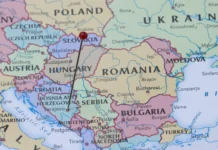High youth unemployment, ethnic tensions and political paralysis help jihadis lure young people to Syria and open up new terror front in heart of Europe
Islamic State has expanded its efforts to recruit fighters in Bosnia and incite terrorist attacks there, taking advantage of the world’s highest youth unemployment rate and chronic political paralysis.
The initiative, though small in scale, is causing alarm in western capitals, where diplomats fear that the mix of economic malaise and ethnic tensions represents fertile terrain for extremism, and that Europe could come to regret the failure to confront Bosnia’s profound structural problems in the two decades since the war.
Isis produced a new recruitment video this month, targeting the Balkans region and Bosnia and Herzegovina in particular. The 20-minute film, entitled Honour is in Jihad, features several Bosnian Isis fighters exhorting their fellow countrymen to join the battle in Syria or carry out opportunistic attacks on perceived enemies of Islam at home.
“If you can, put explosives under the cars, in their houses, all over them. If you can, take poison and put it in their drink or food. Make them die, make them die of poisoning, kill them wherever you are. In Bosnia, in Serbia, in Sandzak [a region in south-west Serbia]. You can do it,” one of the Bosnians, identified by a pseudonym, Salahuddin al-Bosni, implores the audience in Bosnian.
A newly published report on jihadism found: “Returning foreign fighters from Syria and Iraq – battle-hardened, skilled in handling arms and explosives, and ideologically radicalised – pose a direct threat not only to the security of Bosnia and Herzegovina, but also of the region and beyond.”
The report, The Lure of the Syrian War: The Foreign Fighters’ Bosnian Contingent, found that in 2013 and 2014, 156 Bosnian men and 36 women travelled to Syria, taking with them 25 children. Out of that number, 48 men and three women had returned by January of this year.
The authors, Sarajevo University associate political science professor Vlado Azinović and Islamic theologian and columnist Muhamed Jusić, found that Bosnia was ill-equipped to deal with the potential threat. It is a weak state, split by a 1995 peace agreement into two entities, a federation of Muslims (known as Bosniaks) and Croats, and a Serb republic. Furthermore the federation is divided into 10 cantons. Twenty-two police agencies operate in the country with overlapping jurisdictions and roles.
“Generally, there is a lack of coordination between local law-enforcement agencies on [foreign fighter-] related issues,” the report says, noting there is no single database on foreign fighters,and the existing data is “mostly scattered, often incomplete or disorganised”.
“This results in significant gaps in understanding and monitoring of the phenomenon,” it notes, adding that government “lacks a discernible strategy” to confront the looming problem.
“We are not doing anything. We are just observing,” Azinović said.
Kristina Jozić, a spokeswoman for the Bosnian state investigation and protection agency (Sipa), responsible for internal security, said it would analyse the Isis video with a view to identifying Bosnians involved in criminal offences.
“The return of individuals participating in the armed conflict in Syria, fighting with Isis, is undoubtedly a security challenge and a threat, the extent of which is hard to determine at this time,” Jozić said. “Sipa constantly checks allegations of terrorist activities, whether it be on trips to foreign battlefields, financing, recruitment or other terror-related activities … and will take the necessary action.”
According to diplomatic sources, the Sarajevo government is preparing a new counter-terrorism strategy, with greater emphasis on prevention and rehabilitation of returned fighters, and presented a draft to General John Allen, the US special envoy for countering Isis, when he visited Sarajevo on 8 June.
Salafist communities operating outside the official mosques have sprung up in three districts, Gornja Maoča, Osve and Dubnica, and “pop-up” radical mosques, often funded from the Gulf, have appeared in Sarajevo, Zenica and Tuzla.
After three years of observing Bosnian jihadis, the authors place them in two broad categories: veterans who fought alongside mujahideen volunteers from the Arab world in the 1992-1995 Bosnian conflict, and young Bosnian men “driven mostly by adrenaline and a quest for self-validation, self-respect, group belonging, and purpose”. Almost a third of the Bosnian Isis recruits had criminal records.
Chronic deadlock between the rival entities has contributed to economic stagnation and a 63% unemployment rate among young Bosnians, the highest official rate in the world. Bosnian society, which the report says “is gradually losing the ability to manage itself”, is becoming a factor in the flow of Isis recruits.
Like most Isis videos, Honour is in Jihad supplies slickly edited, emotive images married to a seductive narrative. It paints an idyllic picture of insurgent life in Syria, with Bosnian, Kosovan and Albanian fighters walking off to battle like a smiling band of brothers while enjoying time with their families on their days off, complete with complimentary cars.
Isis has produced a stream of similar videos aimed at recruits from France, Somalia, Yemen, Libya and several other countries, each one tailored to local culture and history.
With the use of computer graphics, the film portrays the sweep of Balkan history as a prolonged expropriation of inherently “Muslim lands”, first by “crusaders”, then atheistic communists, and finally nationalists. The current Bosniak political leadership are painted as collaborators with the enemies of Islam “preparing you like sheep for the next genocide”.
With a dramatic skewing of history, the film credits the mujahideen brigade with “repelling the Serbs” in the Bosnian war, although in reality it had a limited impact on a small section of the frontline. Meanwhile it depicts the large-scale US-led air campaign against the Bosnian Serb military as incidental and somehow designed to prevent the rise of the Muslim faithful.
“The massacres will be repeated if Muslims don’t return to your religion,” an elderly jihadi, Abu Safiyah al-Bosni, declares in the film. He is believed to be a Muslim from Sandzak rcalled Abid Podbićanin, and was reported killed in Syria in March.
Salahuddin al-Bosni, who issued the calls for murder earlier in the video and is thought to be a Bosnian called Ines Midzic, apparently died in battle at about the same time. The Bosnian authorities believe another two participants in the film are also dead; another is seriously wounded.
Western government officials believe that the roughly 50 jihadis who have come back to Bosnia so far represent a manageable load for the Bosnian intelligence and security agencies, despite their many divisions and flaws. But they also worry that the scale of the problem could escalate dramatically given the parlous conditions of Bosnia’s economy and society.
In the only potential terrorist incident to cause casualties in Bosnia this year, a 24-year-old Bosniak man from the area around the Serb-run town of Zvornik, drove to its police station on April 27 and opened fire, killing one officer and injuring two others before being shot dead himself.
The gunman, Nerdin Ibrić, was found to have been a friend of a local man who had returned from Syria, but the extent to which he had come under jihadi influence is unclear. Official reports said Ibrić shouted “Allahu Akbar” as he launched his attack, but other accounts said he hurled curses at his targets. It also turned out that Ibrić’s father was among 750 Muslim men rounded up by Serb police and paramilitaries in June 1992, at the start of the war, and killed.
The nationalist Serb authorities reacted as if the shooting had been a major offensive. “This is the worst terrorism attack that could happen in the Serb Republic,” Dragan Lukač, the region’s interior minister, told local television, adding that it “could be the start of much worse events in Bosnia and Herzegovina”.
The Serb leadership used the shooting as a pretext for arresting large numbers of Bosniaks on their territory, and claimed it justified the creation of a new Serb special police squad. Western diplomats argued it was a reason for better coordination among the existing 22 police forces rather than for creating a new one.








